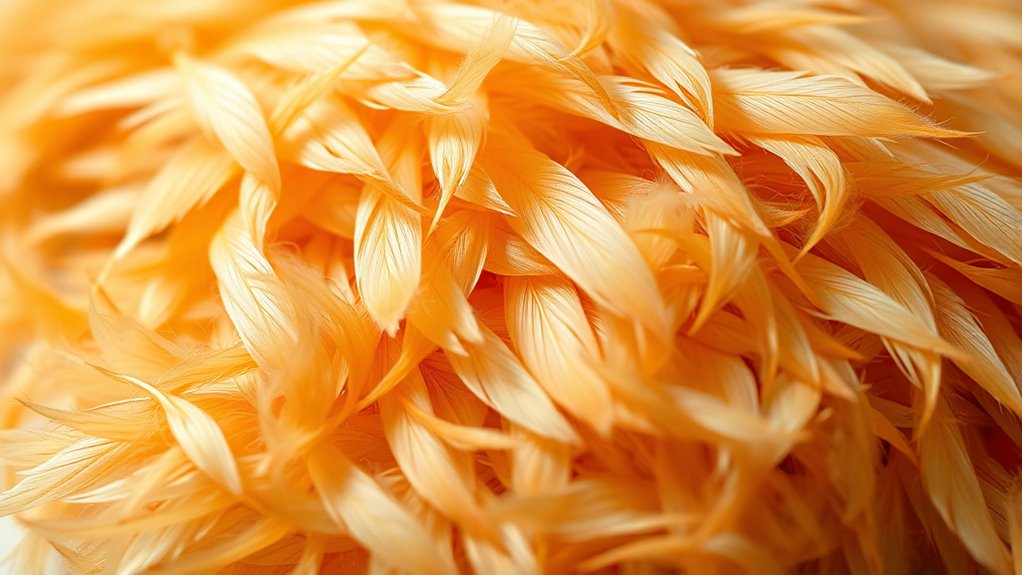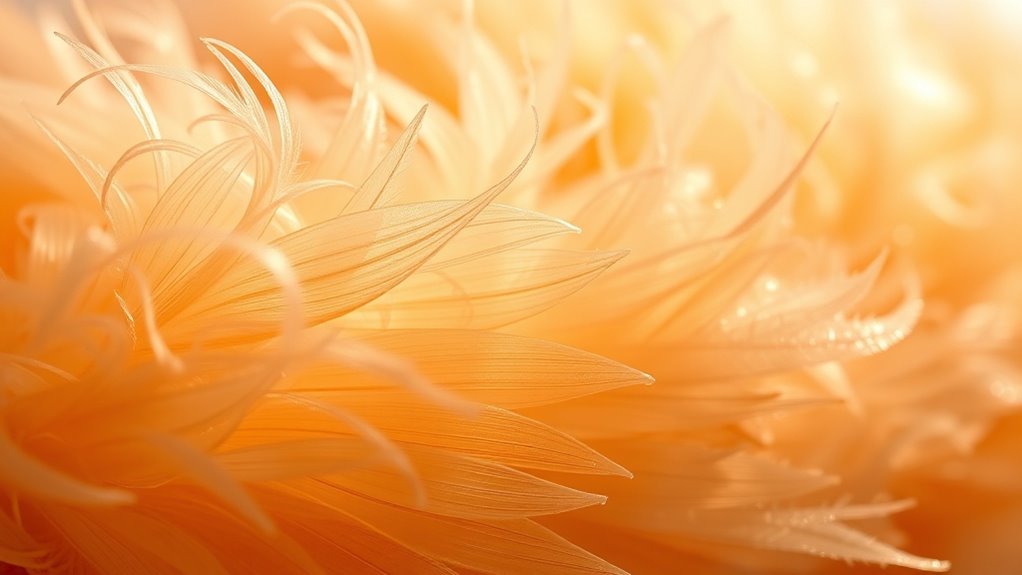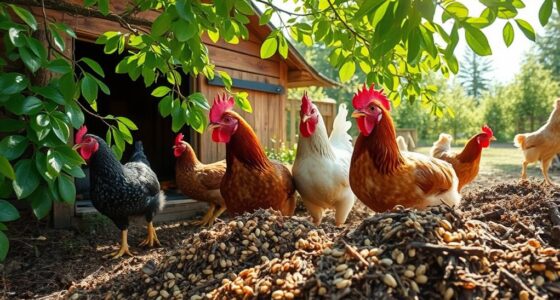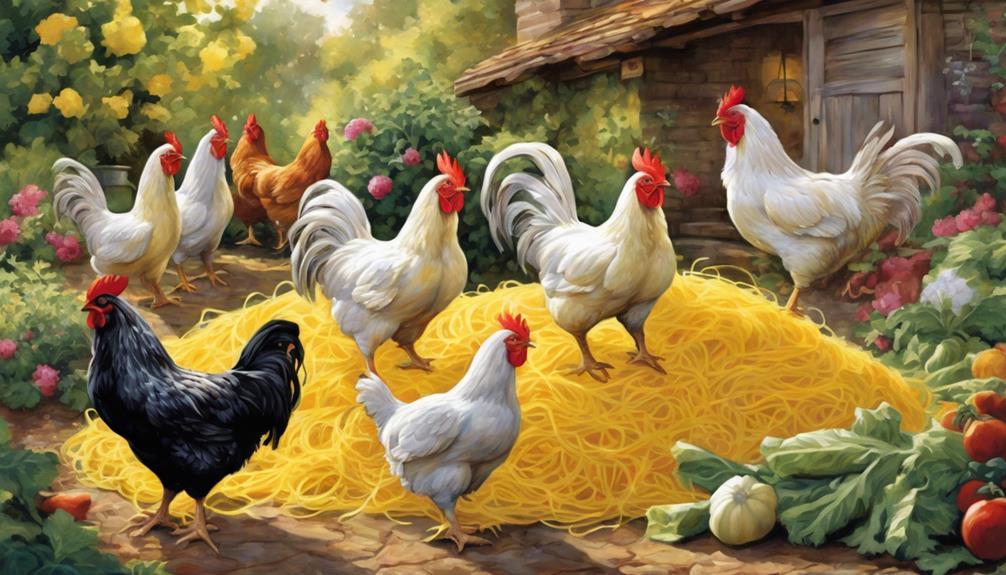Using chicken feathers to make biodegradable plastics offers a promising way to address the waste crisis. Since feathers are rich in keratin, they can be transformed into eco-friendly packaging materials that break down naturally, reducing landfill waste. This innovative approach not only repurposes poultry byproducts but also cuts reliance on petroleum-based plastics. While challenges remain in scaling up and ensuring consistent biodegradability, ongoing research shows great potential—you’ll discover more about how this solution could reshape waste management.
Key Takeaways
- Chicken feathers, rich in keratin, can be transformed into biodegradable plastics to reduce plastic waste.
- Feather-based plastics offer an eco-friendly packaging alternative that decomposes naturally, mitigating landfill accumulation.
- Utilizing poultry waste for plastic production promotes a circular economy and minimizes environmental pollution.
- Developing scalable manufacturing methods enhances the feasibility of replacing conventional plastics with feather-based materials.
- Advancing this technology addresses waste management challenges and supports global sustainability efforts.

As the world searches for sustainable alternatives to traditional plastics, chicken feather-based plastic emerges as a promising innovation. This material offers a potential solution to the mounting waste crisis by transforming an abundant poultry byproduct into useful packaging. Unlike conventional plastics that take hundreds of years to decompose, chicken feather-based plastics aim to be biodegradable, reducing environmental impact considerably. You might wonder how feasible it is to replace familiar materials with something derived from chicken feathers, but research shows that feathers are rich in keratin, a protein that can be processed into bioplastics suitable for packaging applications.
Chicken feathers can be transformed into biodegradable plastics for sustainable packaging solutions.
Sustainable packaging is at the core of this development. You’re probably aware that plastic packaging dominates markets due to its durability and low cost, yet its environmental toll is staggering. Chicken feather-based plastics could bridge this gap by providing an eco-friendly alternative that aligns with global efforts to lessen reliance on fossil fuels. Not only does this initiative help repurpose waste from poultry farms, but it also reduces the demand for petroleum-based plastics. By incorporating chicken feathers into packaging, you’re supporting a circular economy—turning waste into valuable resources—and minimizing landfill contributions.
However, despite its promising potential, chicken feather-based plastic faces notable biodegradability challenges. Feathers are naturally resistant to microbial degradation because of their keratin content, which makes processing into biodegradable plastics complex. You need to understand that converting feathers into a form that breaks down efficiently in compost or natural environments isn’t straightforward. Researchers are working on methods to modify or treat these materials to enhance their biodegradability without compromising strength or functionality. The challenge lies in balancing durability with eco-friendliness, so that the final product performs well during use but decomposes readily after disposal.
Furthermore, scaling up production while maintaining consistent quality presents another hurdle. As you might expect, developing cost-effective manufacturing processes that can produce chicken feather-based plastics at an industrial level remains a work in progress. The goal is to create packaging solutions that are not only sustainable and biodegradable but also economically viable for widespread adoption. This involves optimizing processing techniques, exploring different formulations, and ensuring the material meets safety standards for various packaging needs.
Frequently Asked Questions
How Cost-Effective Is Chicken Feather-Based Plastic Compared to Traditional Plastics?
You’ll find that chicken feather-based plastic is more cost-effective than traditional plastics when considering production and raw material costs. The cost comparison shows potential savings due to abundant feather waste and simpler processing. Its market potential is promising, especially as eco-friendly alternatives gain popularity. While initial investments might be higher, in the long run, this innovative material could reduce costs and environmental impact, making it a viable option for sustainable packaging solutions.
Can Chicken Feather Plastic Be Recycled or Biodegraded Easily?
Imagine a future where waste turns into wonder. You might wonder if chicken feather plastic can be recycled or biodegraded easily. Feather processing technology is advancing, but recycling challenges remain, as feathers are tough to break down. While biodegradable options are promising, they still face hurdles. So, you should stay optimistic—scientists are working hard to make feather-based plastics more eco-friendly and easier to dispose of.
What Are the Environmental Impacts of Producing This New Plastic?
You might wonder about the environmental impacts of producing this new plastic. It reduces livestock emissions because it uses chicken feathers, a waste product, instead of traditional plastics. However, feather sourcing must be managed carefully to avoid overharvesting or disrupting poultry farming. Overall, this process could lower pollution and promote sustainability, but large-scale production requires evaluating supply chains and ensuring responsible sourcing to minimize any negative environmental effects.
Are There Any Safety Concerns With Using Chicken Feather Plastic?
You might wonder about safety when using chicken feather-based plastic. While it’s designed to be eco-friendly, there are concerns about chemical safety, as certain processing chemicals could remain in the material. Additionally, allergen risks exist if residues from feathers trigger allergies in sensitive individuals. It’s essential to thoroughly test this new plastic for chemical safety and allergen risks to guarantee it’s safe for widespread use.
How Scalable Is the Production Process for Commercial Use?
You wonder about the scalability of chicken feather-based plastic production. To get there, you face manufacturing challenges, like optimizing processes and ensuring quality. You also need to navigate a complex supply chain, sourcing abundant chicken feathers and establishing distribution channels. Scaling up means addressing these hurdles efficiently, increasing production capacity, and maintaining sustainability, so you can meet commercial demand without compromising safety or environmental benefits.
Conclusion
So, next time you toss out chicken feathers, imagine them transforming into sleek, eco-friendly plastic—your new armor against the waste apocalypse. Who knew that the fluffy, scruffy plumes could turn into a superhero saving the planet? Soon, your greasy fast-food wrapper might be made from the same feathers that once decorated your dinner. It’s like turning poultry fluff into a shining knight, battling pollution one feather at a time—talk about a poultry revolution!










